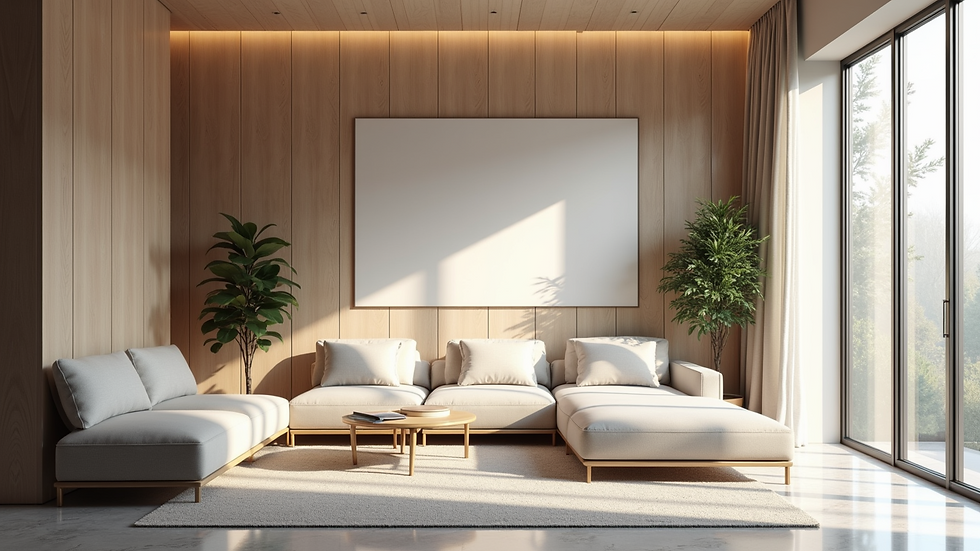Top AI Tools Revolutionizing Architecture and Interior Design with Real-World Use Cases
- Aug 28
- 4 min read
Updated: Oct 8
In the world of architecture and interior design, the adoption of artificial intelligence (AI) is not just a possibility; it is a game changer. Imagine being able to create designs in a fraction of the time, backed by advanced data analysis and superior visualizations. AI tools are empowering architects and designers to work more creatively and efficiently, transforming the traditional design process. This blog post delves into some of the top AI tools in architecture and interior design, complemented by real-world examples that showcase their impact.
The Rise of AI in Architecture and Interior Design
The architecture and interior design fields have historically thrived on innovation. Today, AI tools are elevating this progress by enabling professionals to analyze data rapidly, create diverse design options, and even anticipate preferences from clients. This evolution is not merely about saving time; it is about enabling more tailored and eco-friendly solutions.
For instance, AI tools can assist at every stage, from brainstorming initial concepts to refining final presentations. They analyze extensive data sets, create realistic 3D models, and can even simulate how a space will feel. This speeds up processes that once took weeks and allows architects to channel their focus back into creativity.
Best AI Tools for Architects
1. Autodesk Revit
Autodesk Revit stands out as a leading Building Information Modeling (BIM) software that leverages AI for design enhancement. It enables architects to develop intricate 3D models of structures, integrating not just the aesthetic elements but also mechanical and electrical specifications.
Use Case: Consider a renowned architecture firm that utilized Revit for an expansive urban development project. The AI capabilities within Revit allowed the team to simulate various design scenarios, optimizing energy efficiency. This resulted in a 25% decrease in energy usage post-construction, showcasing a significant environmental benefit.
2. SketchUp with AI Plugins
SketchUp is well-loved for its intuitive 3D modeling capabilities. By integrating AI plugins like Sefaira, users can delve into energy performance analysis while visualizing their designs.
Use Case: An interior designer leveraged SketchUp with AI enhancements to transform a client’s apartment. The AI tools delivered instant evaluations on energy consumption, leading to material choices that ultimately reduced the overall environmental impact by 15%.
3. Spacemaker
Spacemaker is an AI tool tailored for urban planning and architectural design, providing insights into site optimization by evaluating factors like sunlight and wind patterns.
Use Case: A city planning team employed Spacemaker to design a vibrant public park. The software generated multiple layout alternatives, each addressing community needs and environmental sustainability, resulting in a design that improved park attendance by 40%.
Best AI Tools for Interior Designers
4. Modsy
Modsy uses AI to give users a clearer visualization of their interiors in 3D. By simply uploading room photos, users can receive tailored design suggestions that align with their tastes.
Use Case: A homeowner aiming to redesign their living room used Modsy, which enabled them to explore various layouts and color schemes digitally. This visualization reduced the trial-and-error phase before purchases, leading to a design satisfaction rate of 90% upon completion.
5. Houzz Pro
As an all-in-one platform, Houzz Pro integrates AI to enhance project management for interior designers. It simplifies tasks like 3D rendering, financial tracking, and client interaction.
Use Case: An interior designer managing a complex renovation utilized Houzz Pro to ensure project timelines and budgets were met. With the help of its AI features, they increased their project completion rate by 30%, while also receiving consistently positive client feedback.
6. RoomGPT
RoomGPT generates diverse design ideas based on user input about their desired style and functionality.
Use Case: An interior designer tasked with revamping a client’s kitchen employed RoomGPT for inspiration. The AI tool suggested several innovative concepts, leading the designer to finalize a unique kitchen layout that matched the client’s vision, ultimately boosting their referral rate by 20%.
The Future of AI in Architecture and Interior Design
As AI technology matures, its role in architecture and interior design will continue to expand and innovate. Future tools may leverage advanced machine learning techniques to predict trends, automate repetitive tasks, and facilitate collaborative efforts among design teams.
7. AI-Driven Design Assistants
Imagine having an AI assistant that supports architects and designers throughout the design journey. Such a tool could analyze preferences, recommend materials, and generate bespoke design options.
Use Case: A forward-thinking architecture firm is in the process of creating an AI assistant. This assistant learns from completed projects and user feedback, aiming for a smoother design process that significantly enhances creativity.
8. Virtual Reality (VR) and AI Integration
Combining AI with virtual reality is set to transform the way designs are presented. By merging AI-generated concepts with immersive VR experiences, clients can explore spaces before construction.
Use Case: An architecture firm showcased their AI-generated designs in a VR setting during a stakeholder meeting for a commercial building project. The immersive presentation allowed clients to navigate the proposed space, resulting in a substantial 60% increase in stakeholder engagement and collaboration.
Final Thoughts on AI's Impact
The integration of AI tools in architecture and interior design is reshaping how professionals conduct their work. From fostering creativity to significantly boosting efficiency, these tools are opening the door to innovative solutions tailored for modern design needs. As technology advances, architects and interior designers will continue to access powerful resources, enabling them to create awe-inspiring, functional, and sustainable spaces.
Whether you are an architect aiming to enhance your design workflow or an interior designer seeking fresh inspiration for your next project, exploring the top AI tools available can positively influence your work. Step into the future of design and let AI guide your creative journey!





Comments